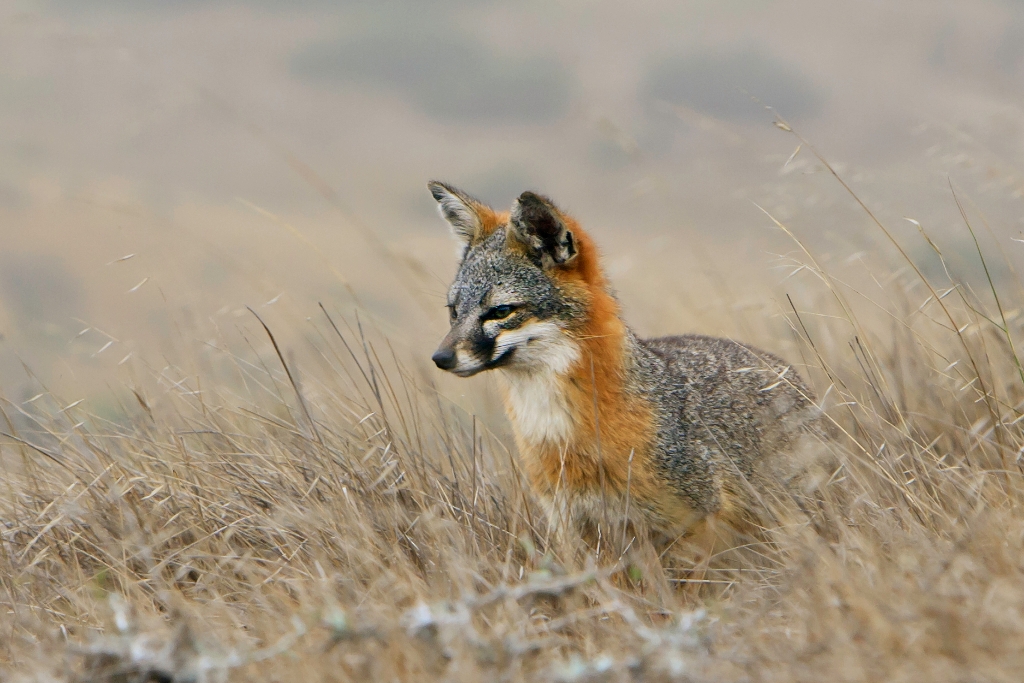
Back from the Brink
Perhaps by now you have been lucky enough to cross paths with an island fox. They are frequently seen in Cherry Canyon as well as around the campground area. The island fox (Urocyon littoralis) lives on six of the eight Channel Islands-San Miguel, Santa Rosa, Santa Cruz, Santa Catalina, San Nicolas, and San Clemente. Each island has its own subspecies, and it is found nowhere else in the world.
The island fox is the largest native mammal on the Channel Islands, but one of the smallest foxes in the world. It is nearly 20 percent smaller than its closest relative, the mainland gray fox. It's about the size of a house cat, averaging from 12 to 13 inches in height, 23 to 27 inches in length (including tail), and three to six pounds in weight. Similar in appearance to the gray fox, the island fox has a gray back, rufous sides (reddish-brown), and white undersides. There are distinctive black, white, and rufous markings on the face.
Unlike the nocturnal gray fox, which hunts at night to avoid predators, the island fox is active during daylight hours. As a "generalist omnivore," it eats almost all available foods on the islands, including fruits, vegetation, insects, mice, and crabs.
Mating takes place in February and March, with pupping usually in April or May. Average litter size is two. The adult males play an important role in the raising of young.
The fossil record for the island fox dates back at least 6,400 years. Since the Channel Islands were never connected to the mainland, scientists currently have two theories on how the fox arrived on the islands. However, due to the scant fossil history, significant questions still remain on the exact mechanism of the initial arrival.
One theory is that the island fox's ancestor, the gray fox, "rafted" to the islands on driftwood, propelled by a storm or currents. During the last ice age, 10-20,000 years ago, ocean levels were up to 400 feet lower than today, narrowing the channel between the islands and mainland to perhaps just four to five miles across and grouping the northern islands together into one large island we call Santarosae. The other theory is that gray foxes were transported to the northern Channel Islands, like they were to the San Nicolas and San Clemente Islands, by American Indians.
The foxes adapted to their new island home, evolving into a dwarf, or smaller, form of the gray fox. Environmental and ecological factors such as overcrowding, reduction in predators, food limitations, and genetic variations could have contributed to the natural selection for a smaller size. As the climate warmed and ocean levels began to rise, Santarosae was divided into the islands of San Miguel, Santa Rosa, Santa Cruz, and Anacapa. Because of a lack of permanent freshwater, the island fox did not inhabit Anacapa Island.
Between 1994 and 1999, island foxes almost disappeared on San Miguel, Santa Rosa, and Santa Cruz Islands. Predation by nonnative golden eagles caused over a 90 percent decline in the population with just 15 foxes left on Santa Rosa, placing the island fox on the brink of extinction. By 2004, the island fox was listed as a federally endangered species.
A successful recovery effort included captive breeding of island foxes, relocation of golden eagles, and the reestablishment of bald eagles (a natural competitor of the golden eagle). In all, on Santa Rosa Island nearly 100 foxes were released over a six-year period with the final fox set free in 2008. Today, with the population at close to pre-decline numbers, the recovery effort has been recognized as one of the quickest and most successful recoveries of an endangered species.
Is there something we missed for this itinerary?
Itineraries across USA


















































